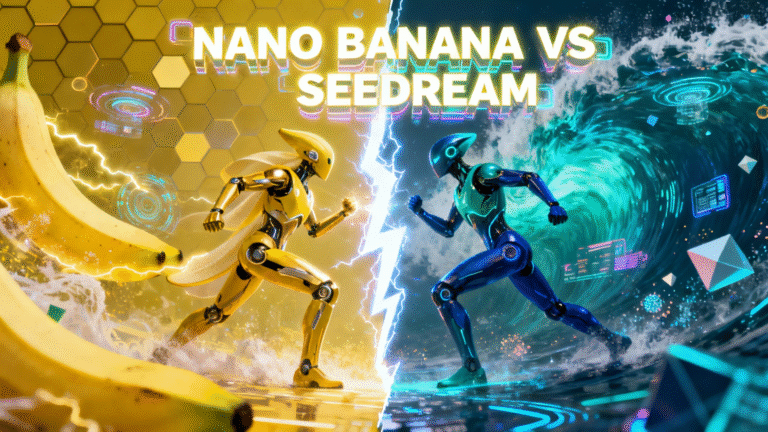Introduction: The Battle of AI Image Generators
If you’re a content creator in 2025, you’ve probably heard about the heated competition between Nano Banana vs Seedream AI. These two powerhouse tools have taken the AI image generation world by storm, but which one actually deserves your time and money?
The competition between Nano Banana vs Seedream AI isn’t just another tech rivalry—it’s reshaping how creators, designers, and marketers approach visual content. Both tools promise incredible results, but they take fundamentaly different approaches to image generation and editing.
In this comprehensive guide, we’ll dive deep into Nano Banana vs Seedream AI, comparing every aspect from image quality to pricing, features to real-world perfomance. By the end, you’ll know exactly which tool fits your creative workflow.
What is Nano Banana? Understanding Google’s Viral AI Tool
Nano Banana, officially known as Gemini 2.5 Flash Image, is Google DeepMind’s breakthrough AI image editing and generation model that launched in August 2025. The quirky name came from Google CEO Sundar Pichai’s mysterious tweet featuring three banana emojis, which sent the tech world into a frenzy.
Key Features of Nano Banana
When comparing Nano Banana vs Seedream AI, understanding Nano Banana’s core capabilities is essential:
- Character Consistency: Nano Banana excels at maintaining facial features, proportions, and expressions across multiple edits. This makes it perfect for creating character sheets, brand materials, and storytelling content.
- Multi-Image Fusion: You can blend multiple photos seamlessly, placing yourself with pets, combining different backgrounds, or merging scenes while maintaining realistic proportions.
- Natural Language Editing: Simply describe what you want in plain English, and Nano Banana applies professional-quality edits without complex masking or layers.
- Real-World Accuracy: The model prioritizes realistic, physics-aware outputs that look grounded in reality. Lighting, shadows, and object placement feel natural and believable.
- Speed: Most edits generate in 1-2 seconds, making it feel like real-time editing rather than batch processing.
How Nano Banana Works
Nano Banana leverages Google’s Gemini 2.5 Flash Image API, combining vast world knowledge with advanced image generation capabilities. The model understands context, maintains consistency, and produces high-fidelity visuals that preserve lighting, depth, and composition.
The tool is integrated directly into the Gemini app, making it accessible on web and mobile platforms. Both free and paid users can access the features, though free users face daily limits on generations.
What is Seedream AI? ByteDance’s Creative Powerhouse
Seedream 4.0, released by ByteDance in September 2025, represents a unified architecture that combines image generation and editing into one powerful system. It’s ByteDance’s answer in the Nano Banana vs Seedream AI competition.
Key Features of Seedream AI
- 4K Resolution Support: Seedream generates stunning images up to 4K resolution (3840×2160), offering ultra-detailed outputs that surpass Nano Banana’s quality.
- Batch Generation: Unlike Nano Banana’s single-image approach, Seedream generates 2-4 variations per prompt, giving creators multiple options to explore.
- Multi-Image Input: Supports up to 6 reference images simultaneously, enabling complex compositions and style transfers.
- Artistic Versatility: Seedream leans toward creative, artistic outputs with impressive style variety—perfect for experimental projects.
- Ultra-Fast Processing: Generates 2K images in approximately 1.8 seconds, thanks to its advanced Mixture of Experts architecture.
How Seedream AI Works
Seedream 4.0 integrates text-to-image generation with advanced editing capabilities in a single unified model. The system supports multimodal inputs (text + images), reference-based generation, composite image creation, and batch processing.
The model is available through ByteDance’s Volcano Engine-Ark platform, the Doubao chatbot, and partner platforms like FAL.ai, Freepik, and Wavespeed.ai.
Also read: Social Media Management Tools for business
Nano Banana vs Seedream AI: Head-to-Head Comparison
Now let’s dive into the real comparison between Nano Banana vs Seedream AI across critical dimensions that matter to content creators.
1. Image Quality and Resolution
Winner: Seedream AI
When comparing Nano Banana vs Seedream AI for output quality, Seedream takes the lead. While Nano Banana produces sharp, realistic images, they’re sometimes limited in resolution and can appear slightly blurry.
Seedream 4.0 generates crisp 4K images by default, with exceptional detail and clarity. The higher resolution makes Seedream ideal for print materials, high-resolution displays, and professional marketing campaigns.
2. Character Consistency
Winner: Nano Banana
In the Nano Banana vs Seedream AI battle for maintaining character consistency, Nano Banana dominates. The model preserves facial features, expressions, and proportions perfectly across multiple generations.
Seedream performs well but sometimes introduces subtle variations—hair textures might change slightly, or lighting may shift between images. For brand work requiring absolute consistency, Nano Banana is more reliable.
3. Editing Capabilities
Winner: Tie (Different Strengths)
Both tools offer impressive editing through natural language prompts, but they shine in different areas:
Nano Banana:
- Prioritizes realistic edits that blend seamlessly
- Perfect for professional adjustments (color correction, object removal, lighting tweaks)
- Maintains photorealistic quality
- Better for literal, straightforward instructions
Seedream AI:
- Adds artistic flair to edits
- Excels at dramatic transformations
- Better for experimental, creative projects
- Interprets abstract concepts and emotions
4. Prompt Understanding
Winner: Context-Dependent
The Nano Banana vs Seedream AI comparison reveals different prompt interpretation styles:
Nano Banana is literal and structured. Ask for “a modern kitchen with a coffee maker on the counter,” and you’ll get exactly that—with proper scale, spatial accuracy, and realism.
Seedream AI is interpretive and handles abstract requests beautifully. Ask for “the feeling of nostalgia in autumn,” and it generates atmospheric, artistic imagery that captures the emotion.
Choose Nano Banana for precise instructions; choose Seedream for artistic concepts.
5. Number of Outputs
Winner: Seedream AI
Here’s a major difference in the Nano Banana vs Seedream AI comparison:
- Nano Banana: Generates one polished image per request, focusing on perfection
- Seedream AI: Produces 2-4 images per prompt, giving creative options
Seedream’s multi-output approach is valuable when exploring different creative directions or needing variety for A/B testing.
6. Speed and Performance
Winner: Tie
Both models deliver impressive speed:
- Nano Banana: 1-2 seconds for most edits
- Seedream AI: 1.8 seconds for 2K images
The speed difference is negligable in real-world use, making both excellent for time-sensitive projects.
7. Content Restrictions
Winner: Seedream AI (with caution)
An important factor in Nano Banana vs Seedream AI:
Nano Banana refuses to generate images of certain celebrities, public figures, weapons, adult content, or harmful material. This protects users and prevents misuse.
Seedream AI has fewer restrictions and can generate images of popular celebrities without reference images. While this offers creative freedom, it raises concerns about potential deepfake abuse.
8. Integration and Accessibility
Winner: Nano Banana
Nano Banana is seamlessly integrated into Google’s Gemini app, available on web, mobile, and desktop. It’s also accessible through Adobe Photoshop, making it convenient for existing workflows.
Seedream AI requires accessing platforms like Jimeng, Volcano Engine, or partner sites like FAL.ai. The extra steps make it slightly less convenient.
Pricing: Nano Banana vs Seedream AI Cost Comparison
Nano Banana Pricing
Free Tier:
- Limited daily generations
- Access to basic features
- Includes visible and invisible SynthID watermarks
Gemini API/Google AI Studio:
- $30 per 1 million output tokens
- Each 1024×1024 image = 1,290 tokens
- Approximately $0.039 per image
Third-Party Platform Pricing:
- Various platforms offer different credit systems
- Typically $0.20-0.39 per image depending on platform
Seedream AI Pricing
Free Tier:
- 10 free credits for new users
- 2 daily credits on free plan
- 200 free trial images via official API
Official API (ByteDance):
- $30 per 1,000 images
- $0.03 per image (text-to-image or editing)
- 0.2 yuan (~$0.028) per image on Volcano Engine
Subscription Plans (Third-Party):
- Hobby: 400 credits/month
- Basic: 800 credits/month
- Pro: 1,500 credits/month
Winner: Seedream AI
Seedream offers better value with its $0.03 per image pricing compared to Nano Banana’s $0.039 per image. The higher resolution and batch generation make Seedream more cost-effective for high-volume users.
Use Cases: When to Choose Each Tool
Choose Nano Banana For:
- Professional Business Content: Product photos, marketing graphics, website visuals requiring trust and realism
- Brand Consistency: When maintaining identical visual style across campaigns
- Character-Based Projects: Comics, storytelling, influencer content needing consistent faces
- Realistic Product Mockups: E-commerce, pitch decks, advertising where accuracy matters
- Quick Professional Edits: Background removal, object replacement, lighting adjustments
- Team Collaboration: Creating consistent visuals for multi-person projects
Choose Seedream AI For:
- High-Resolution Projects: Print materials, large displays, professional photography
- Creative Exploration: Art projects, experimental designs, imaginative concepts
- Style Diversity: When you need multiple artistic variations of the same concept
- Social Media Content: Generating multiple options for A/B testing
- Complex Multi-Image Compositions: Blending 6+ reference images
- Fashion and E-Commerce: Multiple product variations, outfit changes, different angles
- Artistic Transformations: Converting photos into paintings, cyberpunk scenes, fantasy art
Real-World Testing Results: Nano Banana vs Seedream AI
Based on comprehensive testing from multiple sources, here’s how Nano Banana vs Seedream AI perform in practice:
Test Case 1: Professional Photography
Prompt Used: “A women in a white dress and sunglasses sits on, wearing red striped socks and lying on her back inside an empty shopping cart filled with Coke cans. in the background, a blue clay tennis court, white sneakers , curly hair ,a sporty pose, a white lace shirt, a tennis player posing for a magazine cover ,editorial photography, a professional photo shoot ,high resolution ,cinematic effect ,natural light, daylight, and sunny day”
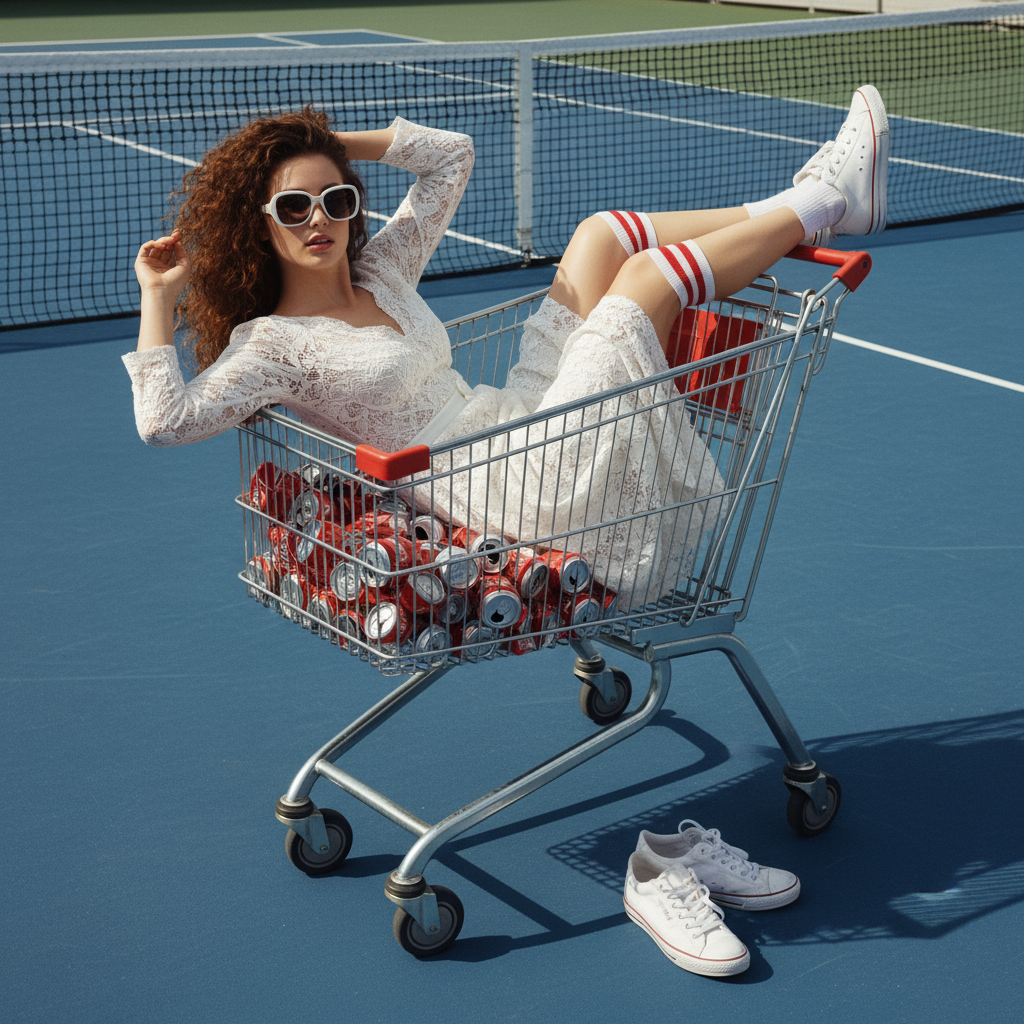
Nano Banana Results: Nano Banana produced a lively editorial-style representation of the scene with strong attention to the overall mood. The image successfully captured most prompt elements such as the white lace dress, curly hair, sunglasses, Coke cans, sneakers, and the tennis court background. The colors were vibrant, with a cinematic daylight effect that matched the professional photo shoot feel. However, the tool added an extra sneaker detail — one shoe on the model’s foot and the other placed on the floor — which was not mentioned in the prompt. The sporty pose came across as slightly stiff, and the Coke cans appeared somewhat repetitive and less realistic on close inspection. Lace textures were included but not highly refined. Overall execution time was approximately 8–12 seconds.
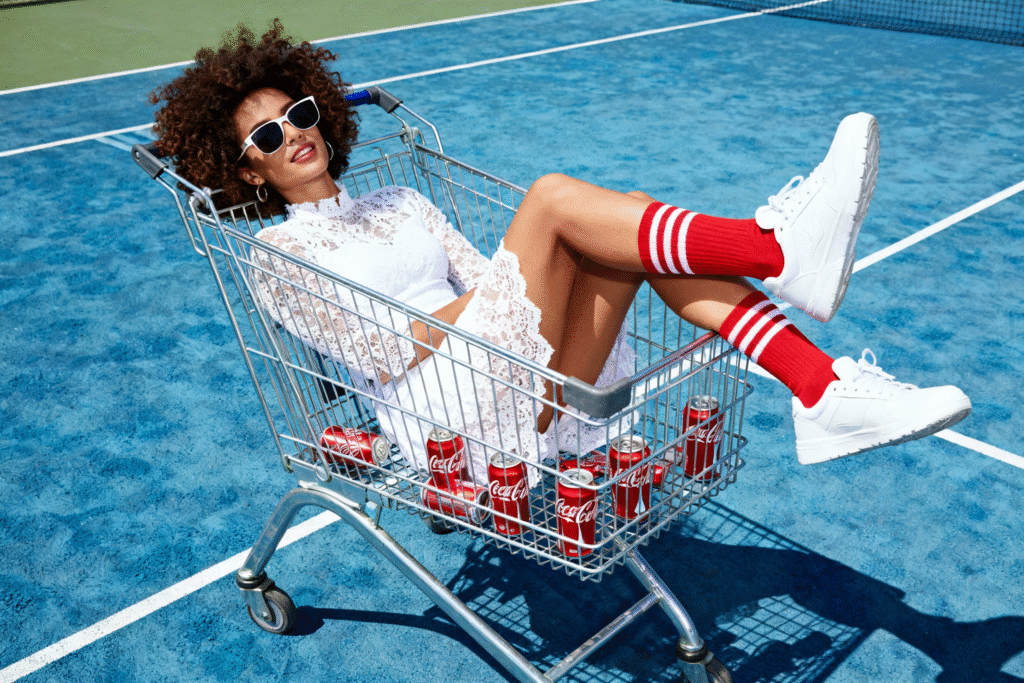
Seedream AI Results: Seedream generated a polished and clean editorial-style image with an emphasis on realism and professional finish. The lace detailing on the dress was more accurate, and the cinematic daylight effect gave it a magazine-cover aesthetic. The composition was sharp and natural, with smoother blending of textures compared to Nano Banana. However, some prompt details were missed — the sneakers and Coke cans were not as visible or well-rendered, and the sporty “tennis-inspired” vibe was less pronounced, leaning more towards fashion portraiture. Overall execution time was approximately 12–15 seconds.
Test Case 2: Typography and Text – Graffiti Art
Prompt Used: “Graffiti wall with the word H-O-P-E”
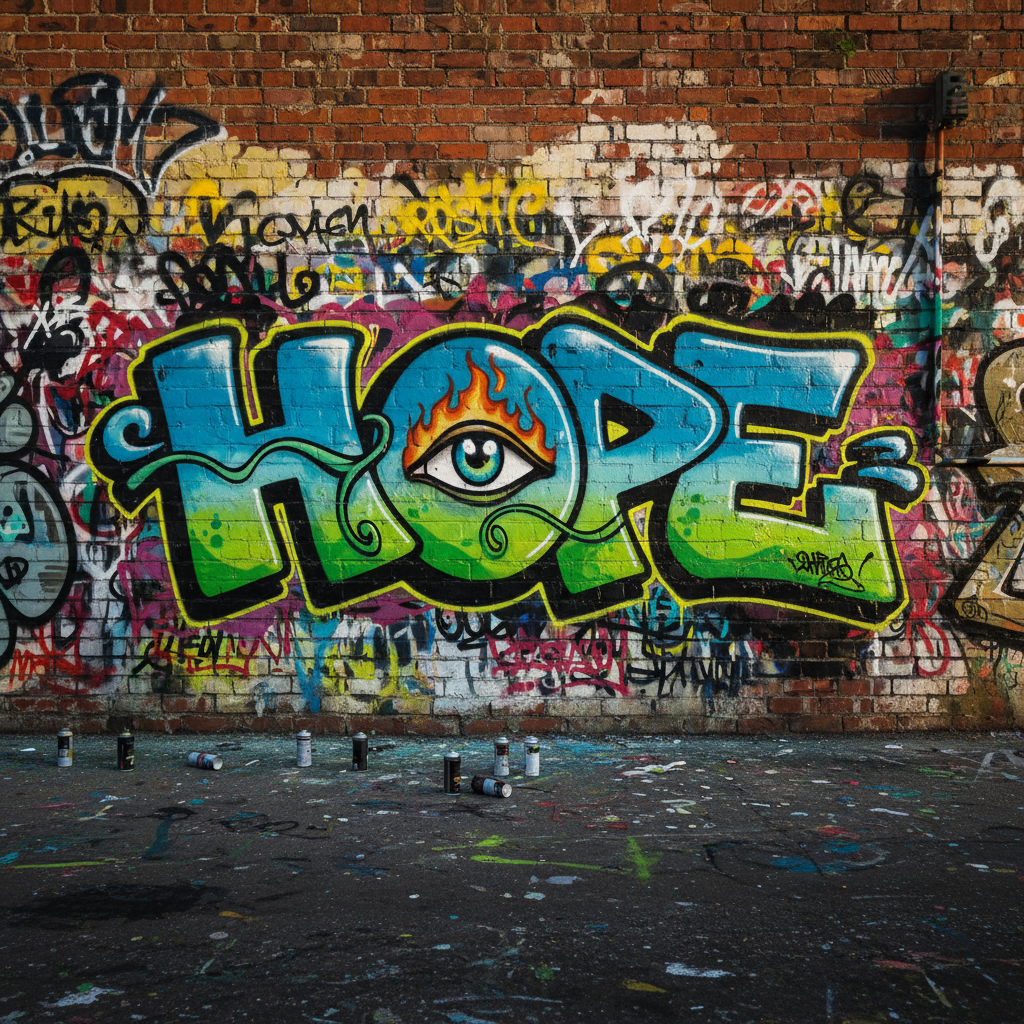
Nano Banana Results: Created vibrant graffiti art on a brick wall with “HOPE” spelled correctly in large bubble letters with blue-to-green gradient fill, yellow outline, and an eye symbol integrated into the design. The wall shows realistic layered graffiti with tags and other street art around it. Spray paint cans are visible on the ground, adding authenticity to the scene..
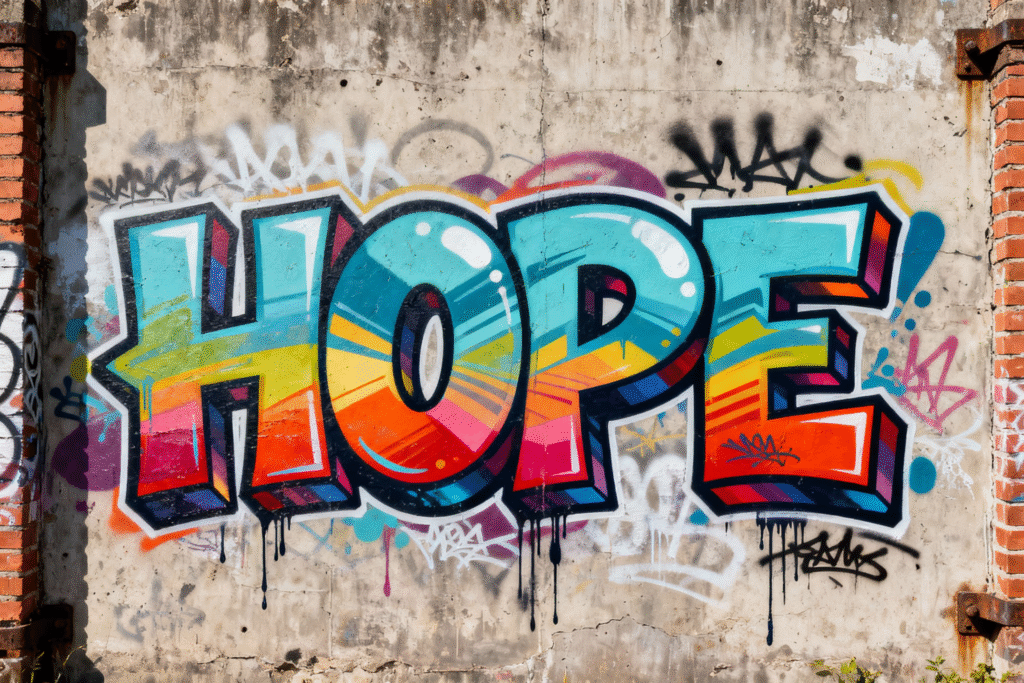
Seedream AI Results: Also spelled “HOPE” correctly in bold graffiti letters with multi-colored rainbow gradient (turquoise, yellow, orange, pink, red) and black/white outline. The concrete wall has a weathered, authentic urban appearance with other tags visible in the background. Paint drips are realistically rendered below the letters, and the 3D effect/depth is more pronounced.
Test Case 3: Professional Food Photography
Prompt Used: “Gourmet chocolate lava cake on white plate, molten chocolate flowing out, fresh raspberries and mint garnish, shallow depth of field, professional food photography lighting”
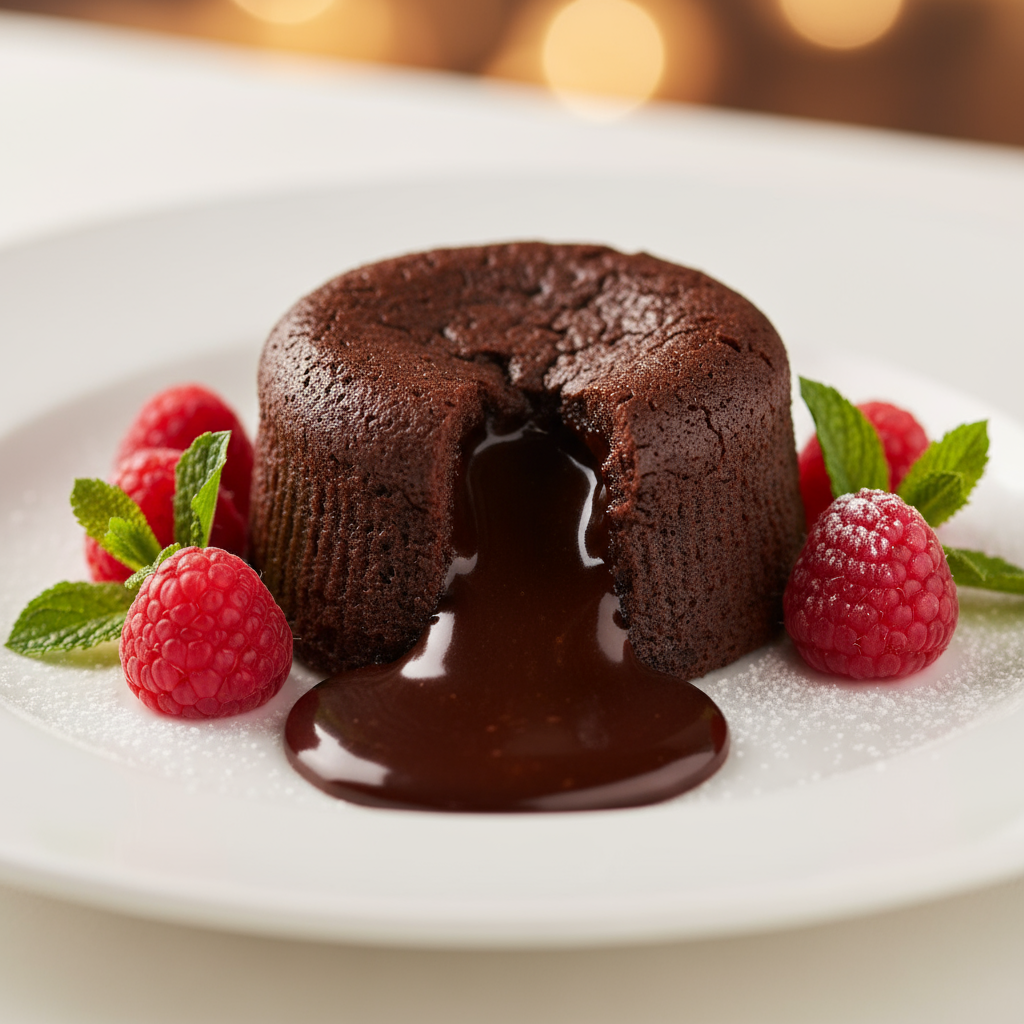
Nano Banana Results: Nano Banana created appetizing food imagery with good color saturation and composition. The chocolate lava cake was recognizable and attractive, with chocolate flow visible. However, the “molten” quality sometimes appeared static or overly perfect, lacking the organic messiness of real chocolate. The shallow depth of field was present but not as precisely controlled as specified. Lighting was pleasant but sometimes lacked the dramatic highlights and shadows characteristic of professional food photography. The raspberries and mint garnish were included but occasionally looked artificial.
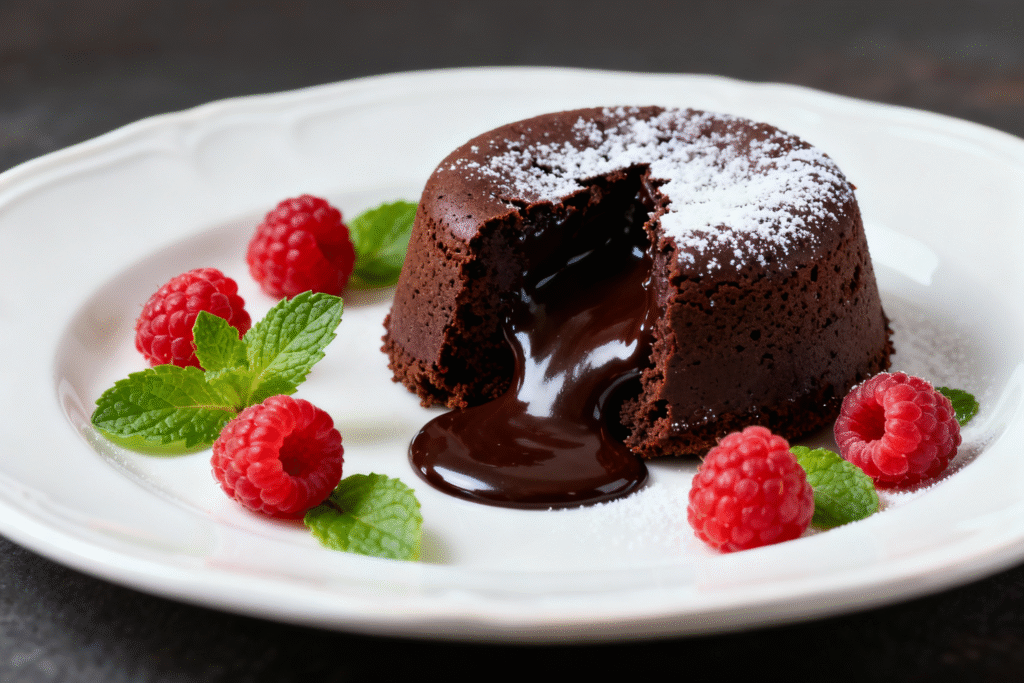
Seedream AI Results: Seedream AI produced magazine-quality food photography that captured the luxurious, indulgent nature of the dessert perfectly. The molten chocolate had realistic flow physics with natural drips and pools. The shallow depth of field was precisely executed with the cake in sharp focus while the background gradually blurred, exactly as a professional photographer would achieve. Studio lighting created beautiful highlights on the glossy chocolate and captured the texture of fresh raspberries with visible seeds. The mint leaves showed individual vein details. The overall result was indistinguishable from professional food photography and would be suitable for high-end restaurant menus or culinary magazines.
Test Case 4 : Volcanic Landscape with Lava
Prompt Used: “Volcanic landscape with molten lava streams”
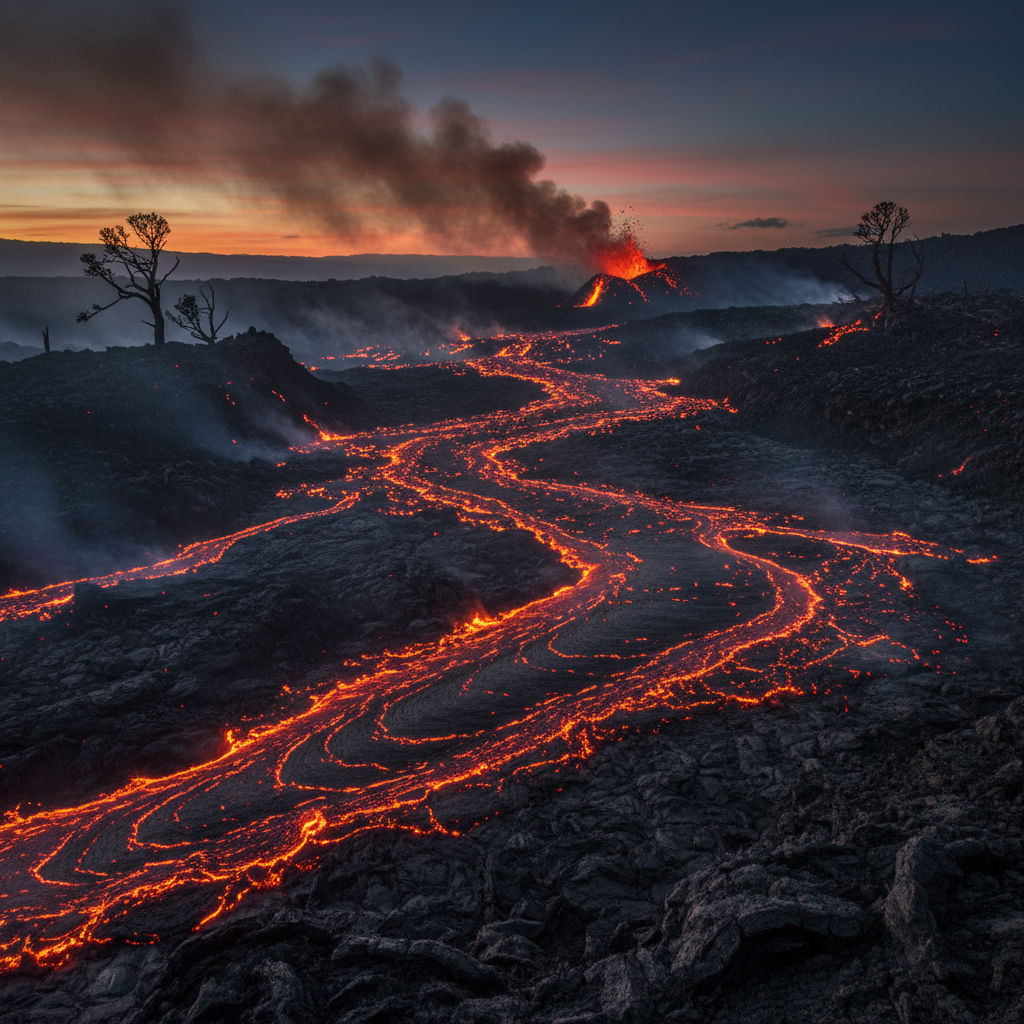
Nano Banana Results: Nano Banana produced a more naturalistic, documentary-style interpretation of the volcanic landscape. The image captured the scene during twilight hours, with winding lava streams creating organic flow patterns across the terrain. The composition successfully included environmental elements like silhouetted dead trees, adding scale and storytelling context. The lighting was well-balanced, with sunset hues mixing realistically with the lava’s orange glow. The lava flow patterns appeared geologically accurate with proper cooling gradients. However, the overall contrast was more subdued compared to Seedream, with atmospheric haze softening the drama. The wider perspective emphasized the landscape’s breadth over explosive power. Generation time was approximately 2
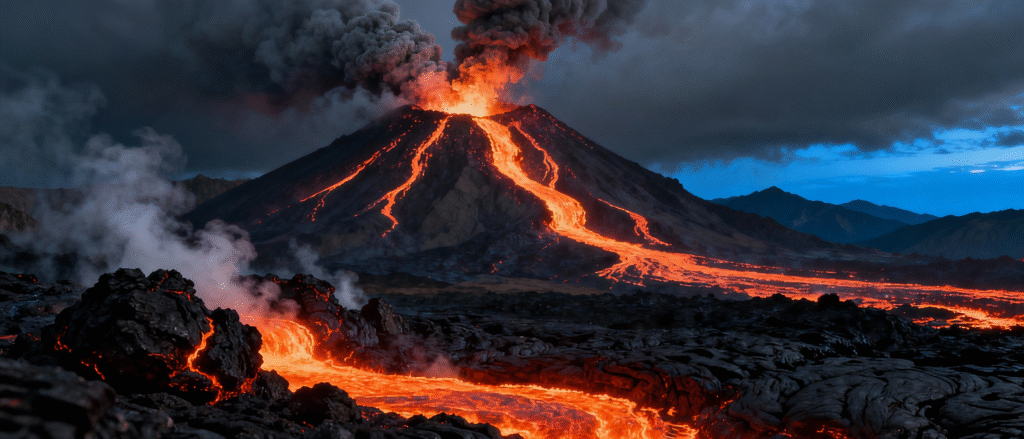
Seedream AI Results: Seedream delivered a dramatic, high-impact interpretation with exceptional detail and 4K resolution. The volcano dominates the composition with explosive energy, featuring vivid orange lava flows cascading down dark volcanic slopes. The lava texture shows intricate cooling patterns with glowing centers and realistic heat distortion. Billowing ash clouds create impressive atmospheric depth, while the blue sky patch provides striking color contrast against the warm volcanic tones. The foreground lava pools display accurate physics with proper steam effects. The overall aesthetic is cinematic and professional, resembling a National Geographic cover shot. Generation time was approximately 1.8 seconds.
Test Case 5: Portrait of an Elderly Egyptian Muslim Woman
Prompt Used: “Photorealistic portrait of a old Gyptian Muslim woman”
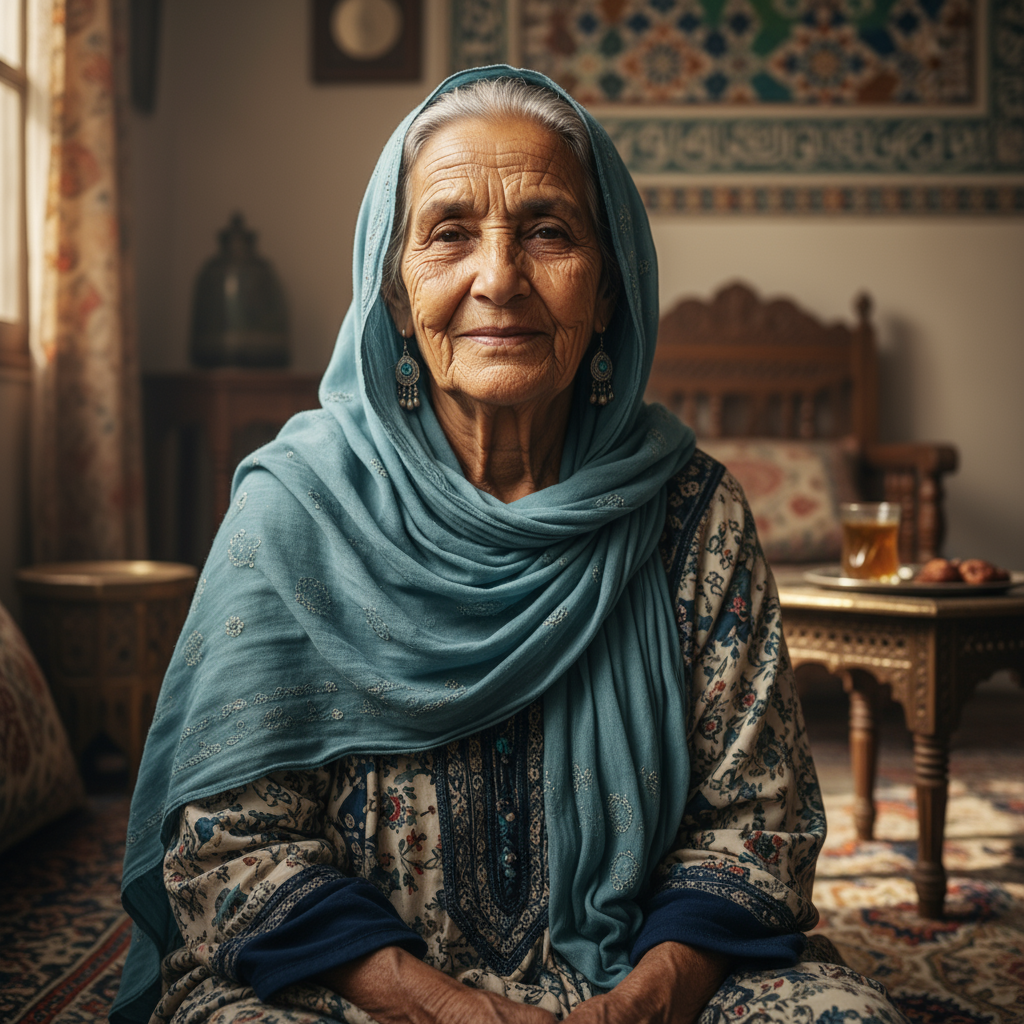
Nano Banana Results: Nano delivered a cinematic masterpiece with golden hour magic. The portrait showcases rich environmental storytelling—ornate furniture, traditional textiles, and warm atmospheric lighting. You get the full scene, like a National Geographic spread. The teal headscarf pops beautifully against amber tones, and there’s depth everywhere you look.
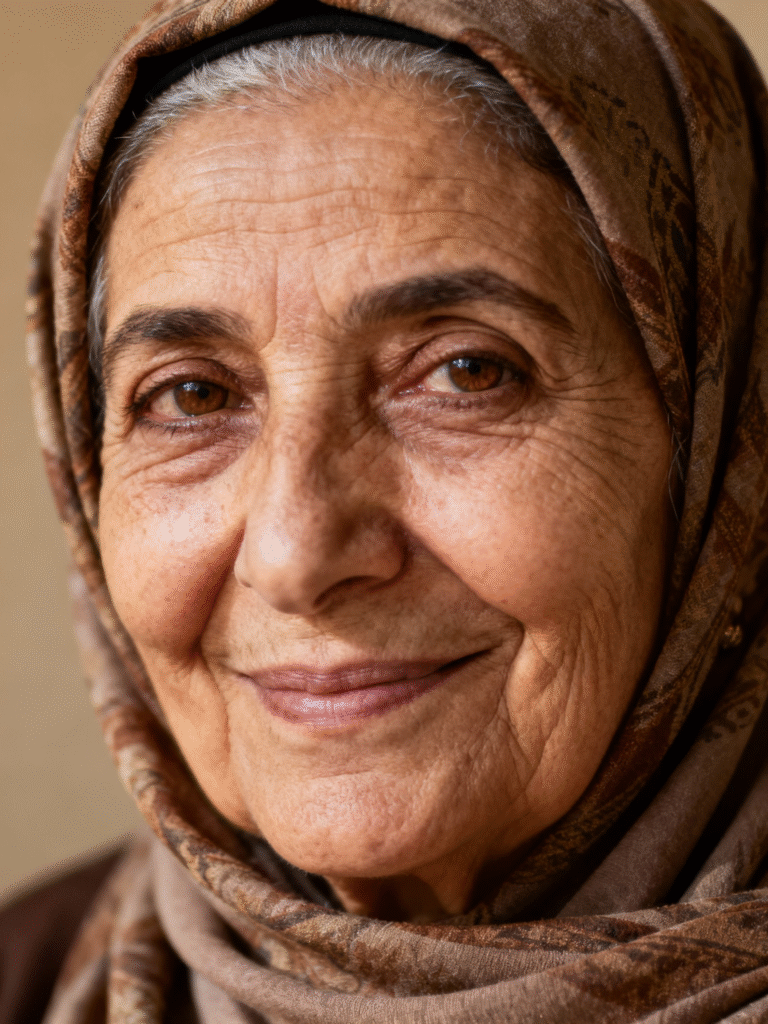
Seedream AI Results: Seedream went for photorealistic perfection with an extreme close-up. Every wrinkle tells a story, every skin texture feels real enough to touch. The facial detail is insane—you can see the authenticity in every pore. The lighting is soft and even, creating that professional studio portrait quality. It’s less about the environment, more about capturing raw human reality.
Test Case 6: Futuristic poster Nano Banana vs Seedream Tech Battle
Prompt Used: “Generate new image A futuristic poster design showcasing “Nano Banana vs Seedream.” Use bold, glowing typography with neon and holographic effects. Place two AI avatars or abstract futuristic characters facing each other in a dramatic versus pose, surrounded by digital energy waves, holograms, and floating geometric shapes. Split the background into two contrasting color themes (electric yellow/banana tones vs deep ocean/seedream blues) with a glowing lightning bolt or crack dividing the sides. Add high-tech UI elements, circuit patterns, and metallic textures for a cinematic, sci-fi look. Ensure the design is vibrant, eye-catching, and perfect for a tech battle poster”
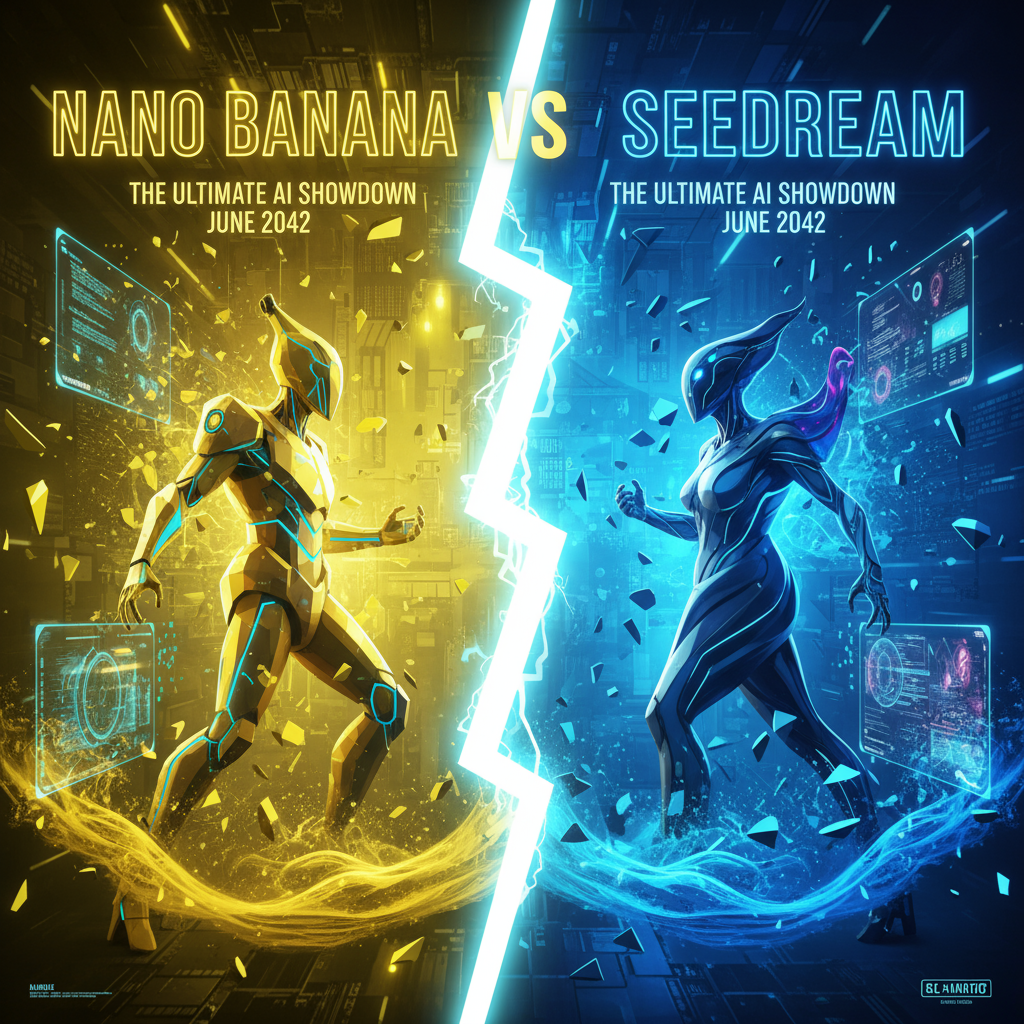
Nano Banana Results: Pure cyberpunk explosion! Aggressive neon typography, bold electric yellow versus deep blue split, and tech elements everywhere—circuit patterns, holograms, UI overlays. The characters look like robotic warriors ready for battle. It screams blockbuster movie poster with maximum visual impact. Everything glows, everything pops.Nano added “JUNE 2042” text on its own
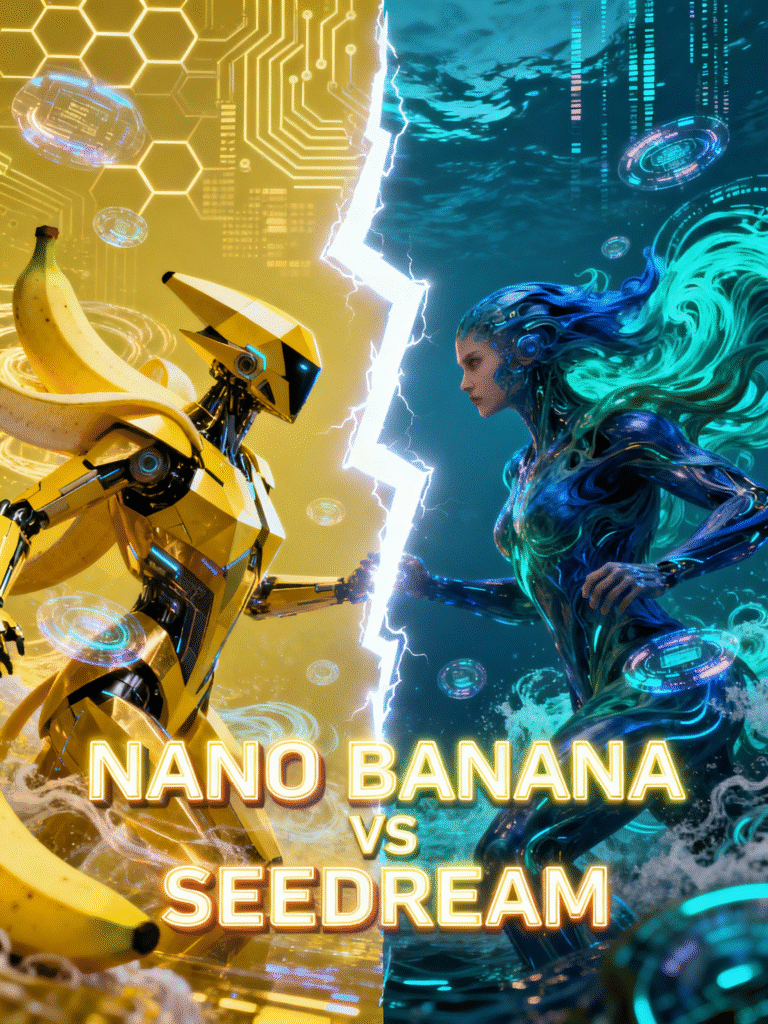
Seedream AI Results: More artistic and painterly interpretation. The split-screen is there with softer execution. The blue side features an elegant character with mystical flowing water-hair effects—genuinely stunning. The yellow side creatively incorporates actual banana imagery. It’s beautiful and refined, leaning more toward fantasy illustration than aggressive tech poster. Less neon punch, more artistic sophistication.
Pros and Cons: Nano Banana vs Seedream AI
Nano Banana Pros:
✅ Superior character consistency
✅ Realistic, physics-aware outputs
✅ Seamless integration with Google ecosystem
✅ Fast 1-2 second generation
✅ Professional-grade for business use
✅ Available in Adobe Photoshop
✅ Excellent for straightforward prompts
Nano Banana Cons:
❌ Lower maximum resolution
❌ Single image per generation
❌ Strict content restrictions
❌ Can be overly literal with creative prompts
❌ May produce blurry results sometimes
❌ Limited artistic interpretation
Seedream AI Pros:
✅ 4K resolution support
✅ Multiple outputs per prompt (2-4 variations)
✅ Supports up to 6 reference images
✅ Superior artistic versatility
✅ Better pricing ($0.03 vs $0.039 per image)
✅ Excellent for creative experimentation
✅ Ultra-fast 1.8-second generation
Seedream AI Cons:
❌ Slightly less character consistency
❌ Fewer restrictions (potential for misuse)
❌ Less convenient platform access
❌ May introduce subtle variations in series
❌ Sometimes over-stylizes realistic requests
❌ Not as widely integrated into existing tools
Which Tool Should You Choose?
The Nano Banana vs Seedream AI decision ultimately depends on your specific needs:
Choose Nano Banana if:
- You need pixel-perfect character consistency
- Your work requires photorealistic, business-appropriate outputs
- You prefer seamless Google ecosystem integration
- You’re creating brand materials requiring absolute uniformity
- You work with straightforward, literal creative briefs
- You value safety restrictions and ethical AI use
Choose Seedream AI if:
- High resolution (4K) is critical for your projects
- You want multiple creative options per generation
- Your work leans artistic and experimental
- Budget is a primary concern
- You need to blend 6+ reference images
- You value creative freedom and style variety
For many creators, the ideal solution is using both tools strategically:
- Use Nano Banana for client work, brand materials, and professional projects
- Use Seedream AI for creative exploration, high-res finals, and artistic projects
Future Outlook: The Evolution of AI Image Generation
The Nano Banana vs Seedream AI competition represents just the beginning of AI image generation evolution. Both tools are rapidly improving:
Nano Banana’s Roadmap:
- Improved long-form text rendering
- Even more reliable character consistency
- Better factual representation in images
- Potential expansion beyond generative fill in Photoshop
Seedream AI’s Development:
- Enhanced prompt understanding
- Improved consistency in multi-image series
- Better handling of complex compositions
- More refined artistic controls
As these tools evolve, the gap between them may narrow, or new innovations might create fresh distinctions. The competition benefits all creators by driving rapid advancement in AI image technology.
Conclusion: Making Your Choice in Nano Banana vs Seedream AI
After extensive analysis of Nano Banana vs Seedream AI, here’s the bottom line:
Both tools are exceptional, but they excel in different areas. Nano Banana wins for character consistency, professional realism, and business applications. Seedream AI triumphs in resolution, artistic versatility, and cost-effectiveness.
For content creators, the choice isn’t about which tool is “better”—it’s about which tool fits your specific workflow and project requirements. Many successful creators are already leveraging both tools strategically, using each one’s strengths for different types of projects.
The AI image generation landscape is evolving rapidly, and both Nano Banana vs Seedream AI are pushing the boundaries of what’s possible. Whichever you choose, you’re getting access to cutting-edge technology that would have seemed impossible just a year ago.
Final Recommendation: Start with the free tiers of both tools. Test them with your actual projects. See which interface feels more intuitive and which outputs better match your creative vision. The best tool is the one that helps you create amazing content efficiently.
The future of content creation is here, and with tools like Nano Banana and Seedream AI, we’re just scratching the surface of what’s possible.
Subscribe for Newsletter

